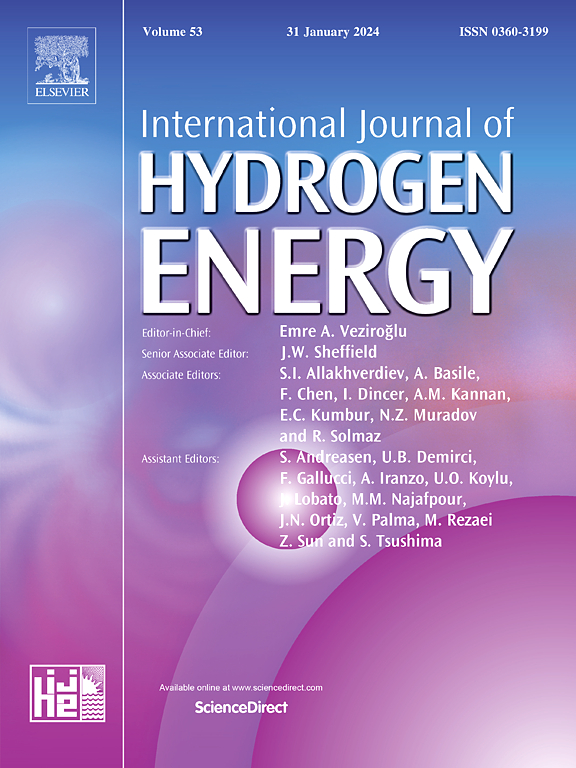Laser pyrolysis of biomass: Comparing cellulose-rich and lignin-rich feedstocks for hydrogen rich-gas production
IF 8.3
2区 工程技术
Q1 CHEMISTRY, PHYSICAL
引用次数: 0
Abstract
The increasing global demand for sustainable energy solutions necessitates innovative approaches to hydrogen production. This study investigates the use of laser pyrolysis as a rapid and efficient method for converting biomass into hydrogen-rich gas, biochar, and bio-oil. Olive stones and onion post-harvest waste were chosen as feedstocks due to their abundance, low cost, and distinct chemical compositions. Experiments were conducted under varying laser power levels (25 %, 50 %, and 100 %), from a continuous wave CO2 laser to achieve high heating rates and rapid decomposition. Comprehensive analyses, including FTIR, GC-MS, and Raman spectroscopy, were employed to characterize the products. The results revealed that hydrogen yield increased with increasing laser power for both biomass samples. Notably, the hydrogen yield was significantly higher for onion waste compared to olive stones, primarily due to the lower cellulose and hemicellulose content in olive stones. The general trend observed for this yield was: Biomass100 % power > Biomass50 % power > Biomass25 % power. Specifically, Hydrogen (H2) was the dominant component for onion waste, with its concentration increasing from 31.50 % at 25 % power to 36.18 % at 100 % power, and olive stones exhibited lower hydrogen production, with H2 concentrations increasing modestly from 14.31 % at 25 % power to 15.78 % at 100 % power. Moreover, the hydrogen yield for onion waste at 100 % power reached 177.72 L/kg, substantially higher than that of olive stones at 100 % power, which yielded 49.78 L/kg. Furthermore, onion waste produced biochar with a more porous structure compared to olive stones. The gaseous products, predominantly hydrogen and methane, showed significant tunability based on feedstock and laser power, highlighting the flexibility of this technique for targeted product optimization. This study reveals the potential of laser pyrolysis as a transformative technology for biomass valorization, offering a sustainable pathway for hydrogen rich-gas production and co-generation of value-added products.
生物质激光热解:比较富纤维素和富木质素原料生产富氢气体
全球对可持续能源解决方案的需求不断增长,需要创新的氢气生产方法。本研究探讨了激光热解作为一种快速有效的方法,将生物质转化为富氢气体、生物炭和生物油。选择橄榄石和洋葱收获后的废料作为原料,因为它们储量丰富,成本低,化学成分独特。实验在不同的激光功率水平(25%,50%和100%)下进行,从连续波CO2激光器实现高加热速率和快速分解。采用FTIR、GC-MS、拉曼光谱等综合分析方法对产物进行表征。结果表明,两种生物质样品的产氢率均随激光功率的增加而增加。值得注意的是,与橄榄核相比,洋葱废料的产氢率明显更高,这主要是由于橄榄核中纤维素和半纤维素含量较低。该产率观察到的一般趋势是:生物质100%功率>;生物质50%功率>;生物质25%功率。其中,氢气(H2)是洋葱废物的主要成分,其浓度从25%功率下的31.50%增加到100%功率下的36.18%,而橄榄石的氢气产量较低,H2浓度从25%功率下的14.31%适度增加到100%功率下的15.78%。此外,100%功率下洋葱废弃物的产氢量达到177.72 L/kg,显著高于100%功率下橄榄核的49.78 L/kg。此外,与橄榄核相比,洋葱废料产生的生物炭具有更多孔的结构。气体产物,主要是氢气和甲烷,显示出基于原料和激光功率的显著可调性,突出了该技术在目标产品优化方面的灵活性。这项研究揭示了激光热解作为生物质增值变革性技术的潜力,为富氢气生产和增值产品的热电联产提供了可持续的途径。
本文章由计算机程序翻译,如有差异,请以英文原文为准。
求助全文
约1分钟内获得全文
求助全文
来源期刊

International Journal of Hydrogen Energy
工程技术-环境科学
CiteScore
13.50
自引率
25.00%
发文量
3502
审稿时长
60 days
期刊介绍:
The objective of the International Journal of Hydrogen Energy is to facilitate the exchange of new ideas, technological advancements, and research findings in the field of Hydrogen Energy among scientists and engineers worldwide. This journal showcases original research, both analytical and experimental, covering various aspects of Hydrogen Energy. These include production, storage, transmission, utilization, enabling technologies, environmental impact, economic considerations, and global perspectives on hydrogen and its carriers such as NH3, CH4, alcohols, etc.
The utilization aspect encompasses various methods such as thermochemical (combustion), photochemical, electrochemical (fuel cells), and nuclear conversion of hydrogen, hydrogen isotopes, and hydrogen carriers into thermal, mechanical, and electrical energies. The applications of these energies can be found in transportation (including aerospace), industrial, commercial, and residential sectors.
 求助内容:
求助内容: 应助结果提醒方式:
应助结果提醒方式:


